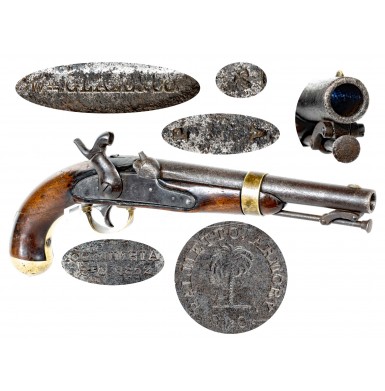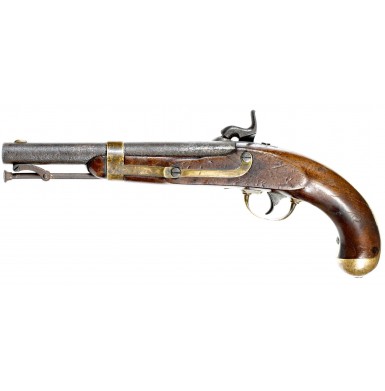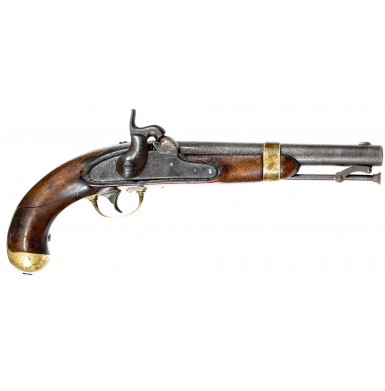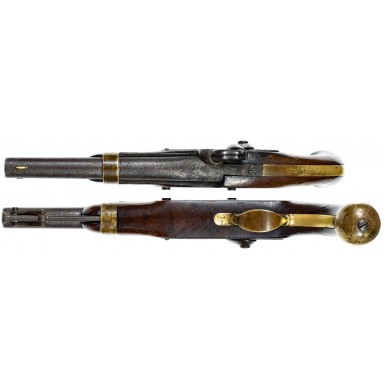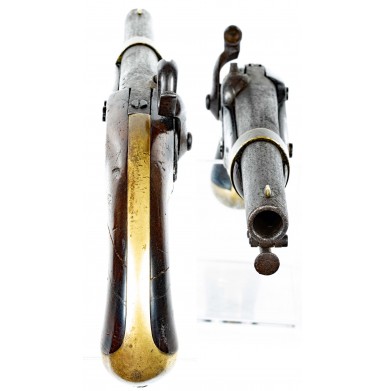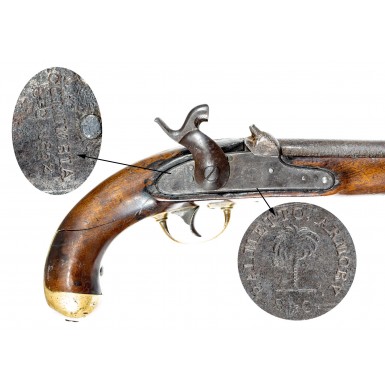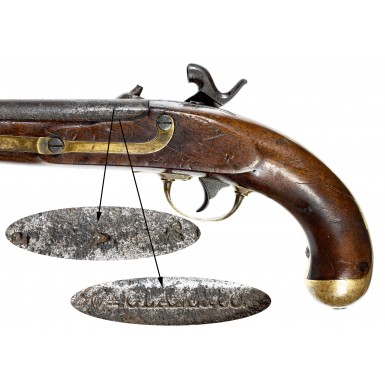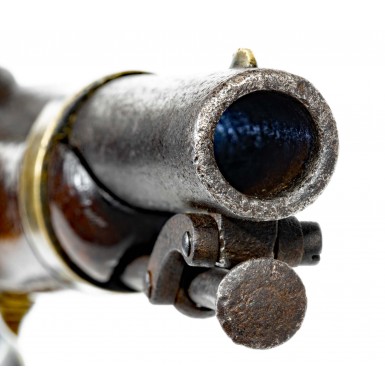Palmetto Armory Pistol - Attic & Untouched
- Product Code: FHG-2171-SOLD
- Availability: Out Of Stock
-
$1.00
William Glaze of Columbia, SC entered the arms business through the same somewhat circuitous route as several other famous antebellum southern entrepreneurs; most notably Hyde & Goodrich of New Orleans. Both were dealers in a variety of items from jewelry to fancy goods and also imported items for sale, with little or no arms experience initially. Glaze entered the jewelry business in the late 1830s and by 1848 had partnered with Thomas Radcliffe of Columbia for a joint venture. Radcliffe was also a jeweler, silver smith and fancy goods dealer who dabbled in firearms sales as well. Antebellum examples of Thomas Radcliffe imported, English-made Tranter revolvers are known to exist, as are other arms that bear his retailer mark. In 1849, the pair entered into an arrangement to sell arms to the state of South Carolina for the use of the state’s militia. That year the state acquired 100 muskets and 274 rifles from the partners, all of which they simply acquired from northern makers and resold at a profit. The rifles were US Model 1841 “Mississippi” Rifles and were made by Whitney, although modified with barrels that would accept a socket bayonet. The muskets appear to have been US Model 1842 percussion muskets that were acquired from Asa Waters, who would play a pivotal role in the soon to be formed Palmetto Armory of William Glaze. The following year the Glaze & Radcliffe partnership sold an additional 640 Model 1842 muskets to the state of South Carolina, this time they were obtained from Benjamin Flagg, who had previously worked as the foreman in the Waters operation and who was attempting to strike out on his own.
By March of 1851, the partnership between Glaze and Radcliffe dissolved, with Radcliffe returning to his pre-partnership business of general line and fancy good sale sales, while Glaze pursued a new career as an “arms maker”. Glaze partnered with Benjamin Flagg and James Boatwright in the establishment of what would be known to history as the Palmetto Armory but that was originally named the Palmetto Iron Works. Boatwright, however, would not remain with the firm for long. Both partners were instrumental in the initial success of the venture, as Glaze had neither manufacturing experience nor any real experience in the arms trade, other than the small group of weapons that had been sold by Radcliffe and himself in 1849 and 1850. As previously mentioned, Flagg had served as Waters’ foreman before venturing out on his own. Flagg had all the required knowledge to establish a functional armory, as well as the contacts to acquire the necessary machinery to make arms, and the contacts to obtain components parts for arms. Boatwright was an old friend of the Glaze family who was politically well-connected, with the necessary contacts to obtain further state contracts for arms.
The looming crisis between southern slave holding states and northern free states was clearly forefront in the minds of the South Carolina government as they sought to establish the ability to manufacture arms within their own state, rather than rely upon arms from northern factories. This path had been successfully followed by the state of Virginia during the first two decades of the 19th century and likely served as a model for the new South Carolina operation that the government sought to establish via Glaze and his partners. In April of 1851, the new company that really only consisted of a factory that was not yet ready to produce much of anything, entered into an agreement with the state of South Carolina to provide the following arms: 6,000 percussion muskets, 2,000 percussion pistols (1,000 pairs) and 1,000 each of rifles, dragoon and artillery sabers. The items ordered and their relative ratios of production (3 times as many muskets as pistols, half the number of dragoon sabers as pistols, etc.) looked quite coincidently like the products and output ratios of the Virginia Manufactory. The contract specified that the arms were to be delivered during the calendar year 1852 and were to be of the current US patterns then in use; in others words the arms were to be US M1842 pattern muskets, US M1842 pattern pistols, US M1841 pattern rifles and US M1840 cavalry and light artillery sabers. However, the most important contract requirement was that: “These arms and their component parts, to be manufactured within the State of South Carolina, of the best material and workmanship and as far as practicable, of material and by mechanics obtained in the state foresaid.” It is clear from that contractual clause that the State of South Carolina was trying to establish a Virginia Manufactory type facility and wanted to be completely independent of any reliance upon the industrial north for the manufacture of the arms. This clause would also be Glaze’s undoing.
It appears that even though Glaze built a factory and acquired some machinery, he never intended to actually fabricate arms in the facility. Rather he intended, at the most, to acquire finished components and assemble them into complete arms. As noted by author Lew Southard in his excellent article The Origin of the Palmetto Pistols (American Society of Arms Collectors Bulletin 81:29-42) the “economy of scale” clearly indicated that Glaze had no intention to manufacture complete arms. The very cost of tooling to manufacture muskets, rifles, pistols and two patterns of sabers would have been so enormous that only large contracts, at least in excess of 10,000 units of each item, would have justified such a capital outlay. By comparison, Southard notes that the initial Henry Aston contract for M1842 pistols was for 30,000 guns, thus justifying the capital investment. It also took Aston nearly two years to from the date of the contract acceptance to the delivery his first pistols. Clearly Glaze’s contract for 2,000 pistols, to be delivered within a year, was only possible if he were to rely upon a source of completed parts, if not completed pistols! The later Ira Johnson contract was for 10,000 M1842 pistols was only economically feasible because Johnson was a partner of Aston’s and had access to the Aston machinery to manufacture the guns, rather than having to tool up from scratch. So, it was upon the Aston-Johnson partnership that Glaze was relying in order to deliver pistols, when he accepted the South Carolina contract. Correspondence exists that proves out this point, that via Glaze’s partner Flagg, as well as the earlier Glaze relationship with Waters, a deal was struck to supply finished components to the Palmetto Armory for assembly into complete pistols. It appears that Johnson was the source for the components and that the locks were assembled by Waters, with all parts subsequently sent to Glaze for final assembly. Further investigation of extant, authentic Palmetto Armory pistols reveals that many of the parts used are condemned parts left over from the Federal contract M1842 pistols, marked with the condemnation “C”, which is sometimes partially or nearly completely obliterated, no doubt intentionally. While it was certainly bad enough that Glaze was violating the contractual requirement that the arms be made within the state from components and raw materials sourced from the state, the use of condemned parts certainly violated the clause that noted the arms were to be of the “best material and workmanship”
The inherent delays in the acquisition of the parts and final assembly of the pistols resulted in Glaze failing to meet his contractual goal of delivery in 1852. This resulted in the cancellation of the contract in May of 1853. However, via cajoling and in some cases outright lying, Glaze managed to convince the state that 1,000 of the guns were mostly ready for delivery. Thus, Glaze managed to salvage part of the pistol contract. In the end, he managed to deliver 1,000 M1842 pattern pistols by the end of 1853. Correspondence reveals that at about the same time the contract was about to be canceled by the state, Glaze had reduced his order of parts from Johnson, Waters, etc. to about 720 component parts. This suggests that Glaze had some forewarning of contractual difficulties. It is also hypothesized that his machinations to retain a part of the contract is the reason that all extant, authentic Palmetto Pistol locks are dated “1852”, while the barrels are dated “1853”, and no guns were delivered prior to late 1853. The theory is that the locks, which had not yet been assembled as of the time of the contract cancellation, were “back dated” to support the claim that the guns were nearly complete. This certainly seems to be a reasonable assumption. Despite the fact that Glaze eventually delivered 6,000 muskets, 1,000 rifles and 1,000 pistols that he had assembled from parts obtained elsewhere, no further contracts for arms “manufacture” were forthcoming. He also delivered some 2,526 swords, which he only stamped his name upon and did not “manufacture” in any sense of the word. Glaze would additionally convert some 6,000 muskets from flint to percussion for the state, but his clear violation of nearly every term of the contract, from delivery time to sourcing parts, to the quality of the parts used, simply excluded him from any serious consideration for arms production for the state in the future.
The Palmetto Armory Pistol, as previously noted, was for all practical purposes a US M1842 Pistol. The guns were brass mounted, singles shot, percussion smoothbore pistols with 8 ½” barrels of .54 caliber and were equipped with a captive swivel ramrod. The parts were provided by Ira N. Johnson and included a combination of condemned parts from both the earlier Aston and later Johnson contracts, as well as some newly finished parts. The locks were assembled by Asa Waters, and it seems likely that Waters applied the Palmetto lock markings as well, as those markings would have to be stamped before the lock plates were casehardened. It is not uncommon to find some, or nearly all of the parts, marked with a condemnation “C” or some other mark (such as a punch dot) suggesting the parts had not been passed for Federal contract use. Additionally, the components should bear no US sub-inspection marks as do Aston and Johnson produced pistols. Unlike the US contract M1842 pistols, which were delivered with bright barrels, the Palmetto pistols were delivered with browned barrels. This may have been an intentional attempt to conceal the flaws or issues with the many second-hand and condemned barrels used. The barrels are typically marked on the left flat with WM GLAZE & CO and with a small Pproof, a small V and a “Palmetto Tree” on the breech where the usual Federal contract larger “V”, “P” and “Eagle Head” marks are found. The rear face of the barrel and the breech plug are typically marked with alphanumeric mating codes, such as “F 4”. The breech plug tangs of the barrels should only be dated “1853”. As noted, the locks of the guns are only dated “1852” and are marked in two horizontal lines behind the hammer: COLUMBIA / S C. 1852. It is worth noting that there is generally not a period after the letter “S” on authentic examples. Forward of the hammer, the locks are marked with the circular legend: PALMETTO ARMORY S * C, surrounding the South Carolina palmetto tree. The letters “AL” and “ME” in “palmetto” and “AR” in “armory” are typically conjoined by the bottom leading and trailing edges of their serifs, respectively. The locks and hammers appear to have been delivered color casehardened, rather than casehardened and polished bright, as they were on US contract guns. As the guns used surplus and condemned components, sometimes earlier pattern parts from M1836 pistols are found on the Palmetto Armory guns. In particular sometimes M1836 triggerguard screws and ramrod swivels were utilized in the assembly of the guns, as well as some M1836 swivel screws.
Offered here is a GOOD condition example of a scarce Palmetto Armory Pistol. The gun has been fully disassembled and is a completely authentic, 100% original Palmetto Pistol. The pistol was previously in the collection of noted Palmetto Amory expert Dr. Fred Novy and was offered for sale several years ago by Shannon Pritchard of Old South Antiques. The gun has a thick, untouched attic patina and shows wonderful age and substantial use. The lock is clearly marked with the circular PALMETTO ARMORY S * C legend, surrounding the usual South Carolina Palmetto Tree. The serifs of the letters “AL” and “ME” in Palmetto and “AR” in Armory connect as they should. The palmetto tree has the correct, unidirectional cross hatched trunk and the lowest left-hand frond correctly contacts the trunk. The rear of the lock is marked vertically in two lines: COLUMBIA / S C. 1852. The locks shows some moderate pinpricking and surface oxidation on its exterior, along with some scattered pitting, while the hammer remains mostly smooth on the exterior and shows moderate pitting on the interior of the neck. The lock remains fully functional and operates crisply and correctly on all positions. A small flaw is present in the lock plate, a minor crack at the top edge at the bridle screw. This does not affect the function of the lock but does indicate the subs standard materials and workmanship that went into these pistols. Both the bridle and mainspring mortises in the stock show worn, partially obscured C condemnation marks. The barrel is marked WM GLAZE & CO on the left flat at the stock line, despite the moderate pitting at the breech, the mark remains quite clear and legible. The breech of the barrel bears a mostly visible Palmetto Tree inspection, followed by a deeply struck small V and small P. The date “1853” is no longer visible on the breech plug tang due to pitting. The rear face of the barrel and the breech plug tang bear the alpha mating mark Y without an associated number. The barrel shows a Ccondemnation mark below the bolster, concealed by the stock, that has been essentially obliterated with a large punch dot. The barrel shows some rough machining and tool marks on its bottom where the workmanship is concealed by the stock. These tool marks would have never been acceptable to a US arms inspector, thus indicating the quality of the workmanship that went into the Palmetto pistols. The barrel retains none of its original browned finish with most of the metal of the barrel showing light to moderate pitting and a relatively thick, oxidized brown patina. Despite the pitting most of the markings remain clear, with the exception of the tang date and part of the Palmetto Tree. The bore of the pistol is dark and heavily oxidized with scattered moderate pitting. The original brass front sight is in place on the top of the barrel, near the muzzle. The captive swivel ramrod is of the M1842 pattern. The rod is moderately oxidized and pitted, matching the barrel, but remains fully functional. The rod is secured by a pair of M1842 pattern swivels. The brass triggerguard has a lightly cleaned golden patina, with the balance of the brass furniture having a darker, untouched patina. neither the triggerguard nor the backstrap bear the condemnation “C” marks that are sometimes found on their interior. Neither do the parts show any Federal sub-inspection marks, indicating these parts were made by Johnson specifically for the Palmetto contract, or were simply overrun production parts. The triggerguard uses a rounded head M1836 pattern screw, which is not uncommon on these guns. The stock of the pistol rates about GOOD and is in about the same condition as the metal, showing substantial age, wear and use. The stock is full-length and has not been sanded, but does show several substantial cracks, the largest and most notable running through the wrist to the triggerguard, leaving a rather visible gap. Additional tighter cracks are also present int the grip and in the counterpane of the stock. The wood shows burn out around the bolster, typical of a percussion gun that saw heavy use and a small piece of wood is missing behind the hammer along the top edge of the lock plate. As would be expected, the stock also shows numerous scattered bumps and dings from service and use. The wood has a polished appearance from years of handling, not unlike an antique banister that has seen decades hands rubbing the length of the wood. The substantial wear present on this example is to be expected, as most of the Palmetto Armory pistols saw significant service during the early days of the Civil War, as handguns were in very short supply in the south for cavalry use.
Overall this a nice, completely authentic example of a scarce Palmetto Armory Pistol, produced for the state of South Carolina in the years immediately preceding the American Civil War. With only 1,000 pistols manufactured, and with the proliferation of fake examples on the market, finding a completely authentic example can be quite difficult. Dr. Novy’s note sheet that accompanies the pistol is dated June 28, 2014, when the gun was examined at Little John’s Auctions as part of the collection of noted author William A. Gary, whose book Confederate Revolvers is a standard reference on the subject. This is well used example of a scarce and desirable secondary Confederate pistol that has a great, well-worn and well-used appearance. It would be a fine addition to any collection of southern arms and represents a great value when compared to the price of any of the Confederate made revolvers. This gun is southern made, from the state that started the American Civil War and lead the south in secession and is about one-quarter the price of the cheapest of the Confederate made revolvers! However, it is still just as Confederate as a Griswold & Gunnison of Leech & Rigdon pistol.
SOLD

